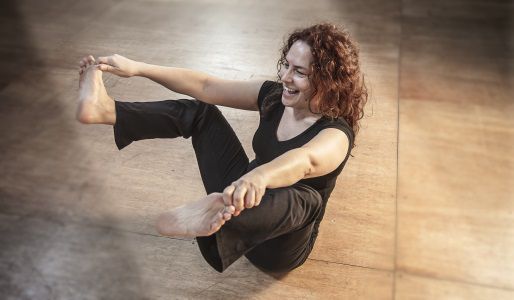“My friends have noticed I’m walking better.” Miriam mentioned this to me one week after her introduction to the Feldenkrais Method® of somatic education. That first session she had learned that, instead of tightening through her “weak” ankles, she could let her ankles relax so her heels could peel off the ground; and that, instead of gripping her toes, she could let her heel-peel relax and lengthen her toes. That 91 year old said, “This is what I’ve been waiting for my whole life.”
The idea that you “can’t teach old dogs new tricks” definitely does not apply to the Feldenkrais Method—unless the student doesn’t want to widen his or her movement repertoire. “But dear, I always do it this way” is what another ninety year old said every time I offered to increase her movement options. She was smart and strong, but insisted on pulling herself up stairs with her arms instead of propelling herself up from the step below with a heel-peel.
I’ve helped many people in their nineties, but one of the most memorable was a lady who came to me with balance and walking issues. She was tightening through her abdominal muscles causing her spine to round into a C-shape, and was stepping way out ahead of herself. During some table work where she learned that her torso could relax and lengthen, I thought to myself, “She is learning fast, but has years of habits to overcome.”
After she sat up, I kind of talked with my body while explaining that, instead of pulling herself forward by stepping way out ahead, she could use the natural heel-peel of each foot to propel herself forward. I also wiggled through my ribs as I mentioned that balance and walking are easier when the torso is relaxed and mobile. She stood up and wiggled through her ribs saying, “You mean like this?” She then walked the length of the room (later down the sidewalk) efficiently and comfortably with perfect balance!
The Feldenkrais lesson on the following page is an excerpt from Walking: Nature’s Perfect Exercise.
Foot & Ankle Flexibility
1. Stand with your feet parallel to each other, not quite as far apart as the distance between your shoulders.
2. Peel one heel off of the ground and then allow it to return to the ground. The front third of the bottom of that foot (“ball” of the foot and “toes”) remains on the ground.
3. Slowly alternate peeling one heel, then the other, off the ground. Wait until the first heel returns to the ground before you lift the other heel.
• Each time one of your heels peels off the ground, allow that knee to move forward. (If you don’t allow the knee to bend as the heel below it peels off the ground, you’ll end up “standing on your toes” instead of relaxing through your toes.)
• When one of your heels peels off the ground, allow the front of that ankle to lengthen.
• Allow the length of the 4th metatarsal to lever you onto the “ball” (heads of your metatarsals). Each time one of your heels peels off the ground, allow a space between your “big toe” and 2nd toe and between your “little toe” and 4th toe — to allow your middle three toes to support your knee.
• Allowing your 1st (big) toe and 5th (little) toe to allow your middle three toes to support your knee means allowing relaxed lengthening through all of your toes.
The human foot is designed for relaxed lengthening through the toes and for bendability where the heads of the metatarsals meet the phalanges. Both of these enable your heels to peel off the ground for comfortable, powerful walking.
Make sure every pair of shoes you own has enough:
» toe- room to allow your toes to spread into relaxed lengthening, and
» bend-ability to allow you to move onto the ball of your foot every time your heel peels off the ground behind you.
If you want to walk faster — instead of making your legs work harder, allow your feet and ankles to be more flexible.

If you enjoyed this lesson, join Pamela in Seattle this summer for her workshop, “Stepping Forward–From Behind.”
 Feldenkrais® practitioner Pamela Kihm has written three books: Walking: Nature’s Perfect Exercise, Stop Sciatica Now, and Relax Your Back With A Roller. Baseball Skeletal Engineering: Catching, Throwing, Batting, Running, written to appeal to teenagers, will be available this fall. She is currently writing a book for those with osteoarthritis.
Feldenkrais® practitioner Pamela Kihm has written three books: Walking: Nature’s Perfect Exercise, Stop Sciatica Now, and Relax Your Back With A Roller. Baseball Skeletal Engineering: Catching, Throwing, Batting, Running, written to appeal to teenagers, will be available this fall. She is currently writing a book for those with osteoarthritis.

